Welcome to Trinetram.
A Yogic Practice for Health, Energy, and Spiritual Awakening
1. Introduction to Surya Namaskar

Surya Namaskar, or Sun Salutation, is an ancient yogic practice that honors the Sun (Surya Bhagawan) as a source of light, energy, and life. This sequence of 12 postures is not just a physical exercise but a spiritual ritual that aligns the body, mind, and soul with the cosmic energy.
Spiritual and Yogic Significance
In the Vedic traditions, the Sun is revered as the supreme source of Prana (life force). The Rig Veda extols Surya as the remover of darkness and the giver of spiritual awakening:
“सूर्य आत्मा जगतस्तस्थुषश्च।” Sūrya Ātmā Jagatas Tasthuṣaś Ca (Rig Veda, Mandala 1, Sukta 115, Verse 1). Means, “The Sun is the soul of the moving and non-moving beings”.
Ancient yogis practiced Surya Namaskar as a way to absorb solar energy, enhance vitality, and deepen meditation.
2. The 12 Poses of Surya Namaskar (Step-by-Step Guide)
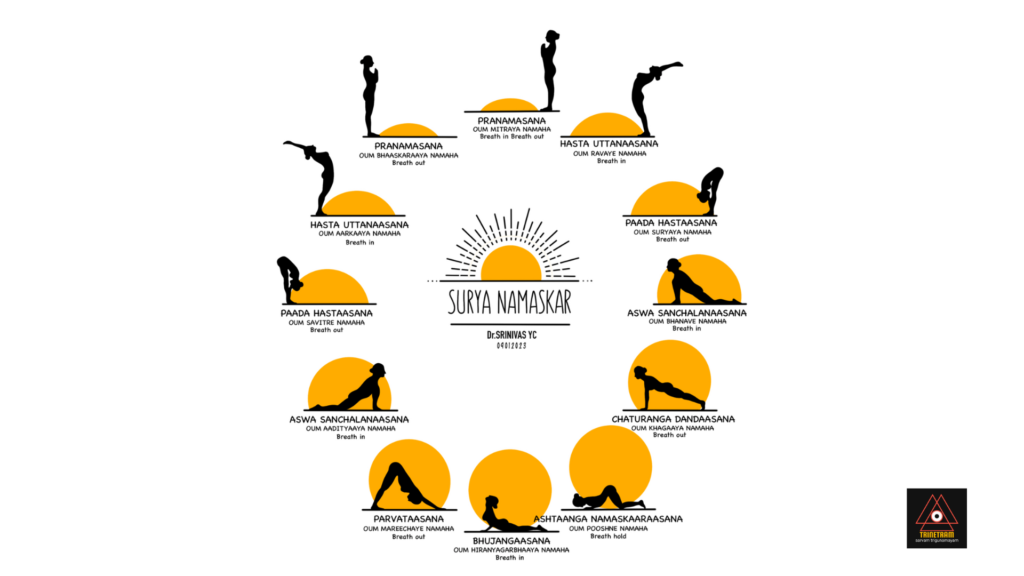
Each posture in Surya Namaskar has a spiritual significance and is designed to activate different chakras: Each pose in Surya Namaskar is performed in a rhythmic flow, synchronized with breath and intention. Below is a step-by-step guide on how to do each pose:
1.Pranamaasana (Prayer Pose) – Stand upright with feet together, hands joined at the chest in Namaste. Keep the spine erect and breathe deeply, setting an intention for your practice. A gesture of gratitude, grounding and connecting with the divine.
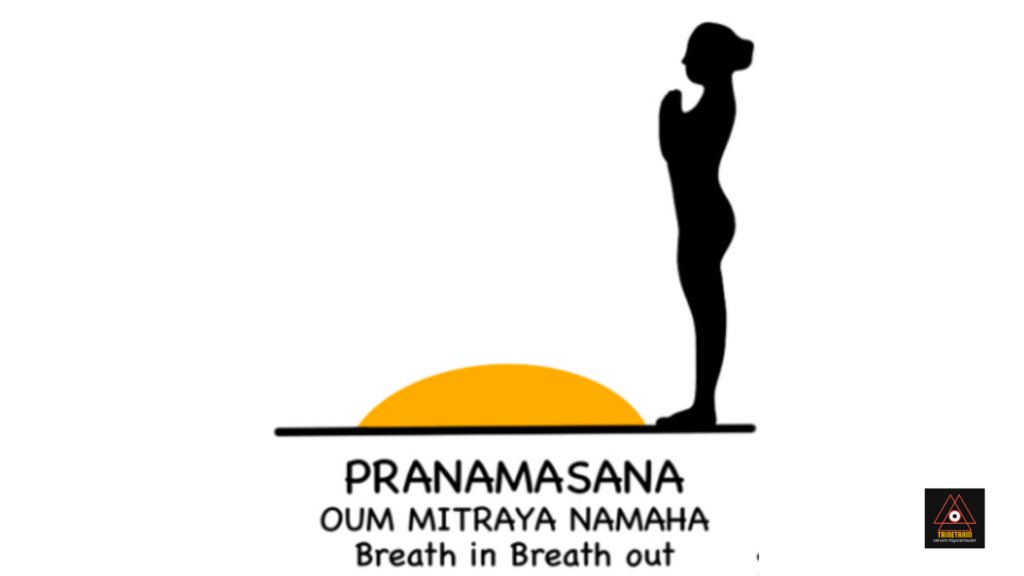
2.Hasta Uttanaasana (Raised Arms Pose) – Inhale, lift the arms overhead, and gently arch the back while keeping the biceps close to the ears. Stretch the whole body upward. Opens the chest, activates Ajna (Third Eye) Chakra, and draws in cosmic energy.

3.Padahastaasana (Hand-to-Foot Pose) – Exhale and bend forward from the waist, keeping the spine straight. Touch the hands to the floor beside the feet while keeping the knees straight, stimulating the Root Chakra. Stretches the spine and stimulates the Muladhara (Root) Chakra.
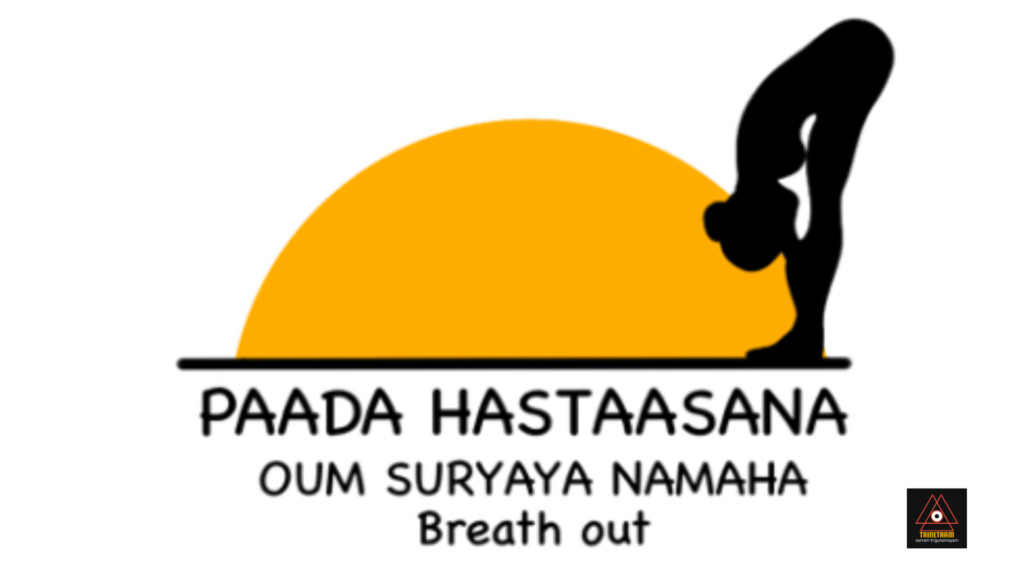
4.Ashwa Sanchalanaasana (Equestrian Pose) – Inhale, step the right leg back, placing the knee on the ground, and stretch the left knee forward. Keep the hands on the floor and lift the chest, gazing upward. Opens the hips and awakens Swadhisthana Chakra (Sacral Chakra)
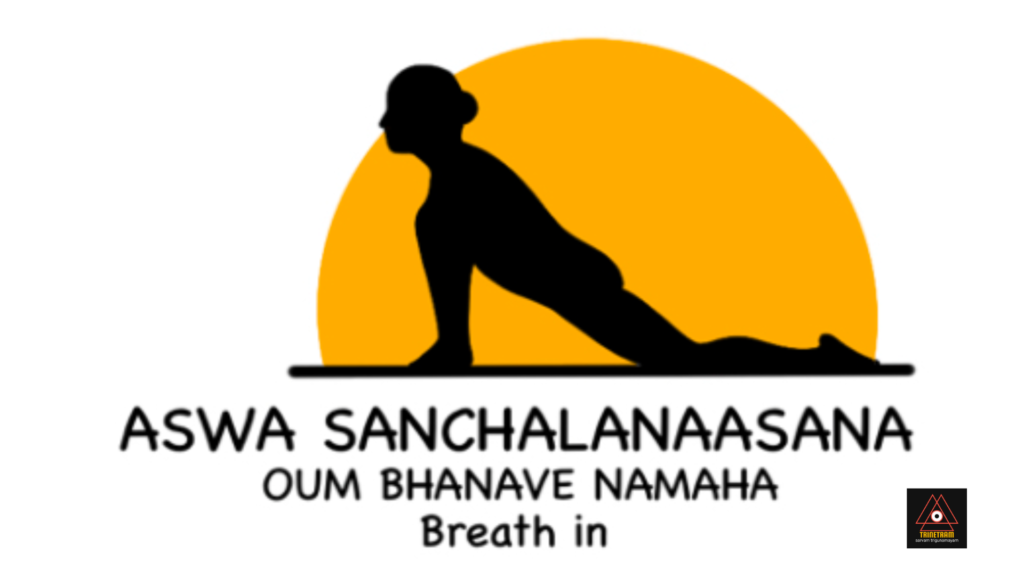
5.Chaturanga dandaasana (Plank Pose) – Exhale, take the left leg back, aligning the body into a straight line from head to heels, engaging the core. Strengthens the core and activates Manipura (Solar Plexus) Chakra
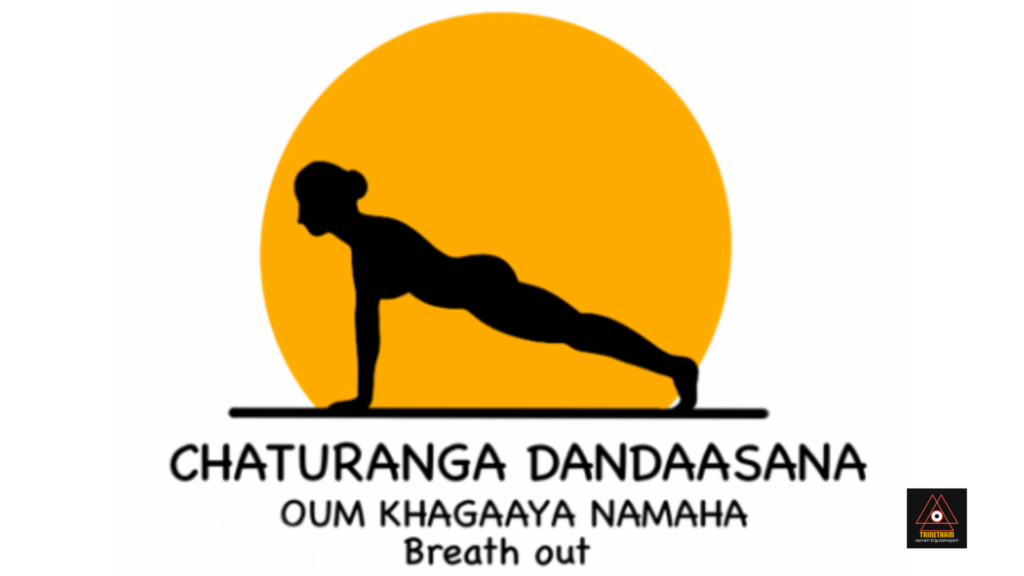
6.Ashtanga Namaskaraasana (Eight-Limbed Pose) – Lower the knees, chest, and chin to the ground while keeping the hips slightly elevated. Eight parts of the body (toes, knees, chest, chin, and hands—together known as the Ashtangas or eight body parts that touch the ground in reverence) touch the floor. A complete surrender to divine energy.
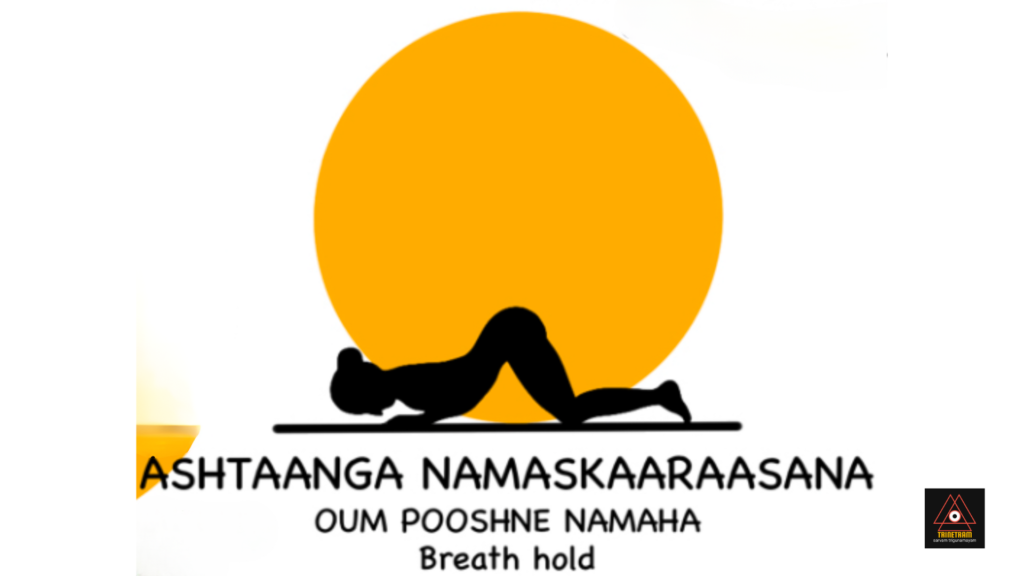
7.Bhujangaasana (Cobra Pose) – Inhale, slide forward, raising the chest while keeping the elbows slightly bent. Open the shoulders and look upward, stimulating the Heart Chakra. Expands the chest, stimulating Anahata (Heart) Chakra.
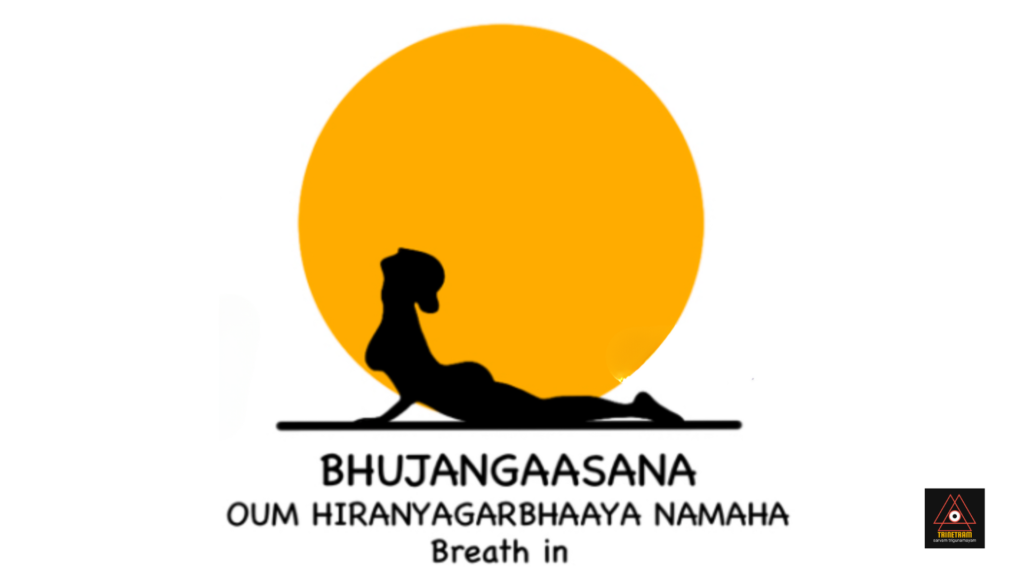
8.Parvataasana (Downward Dog Pose) – Exhale, lift the hips upward, forming an inverted ‘V’ shape. Keep the hands and feet grounded, stretching the spine and calming the mind. Calms the mind, activating Vishuddha (Throat) Chakra.
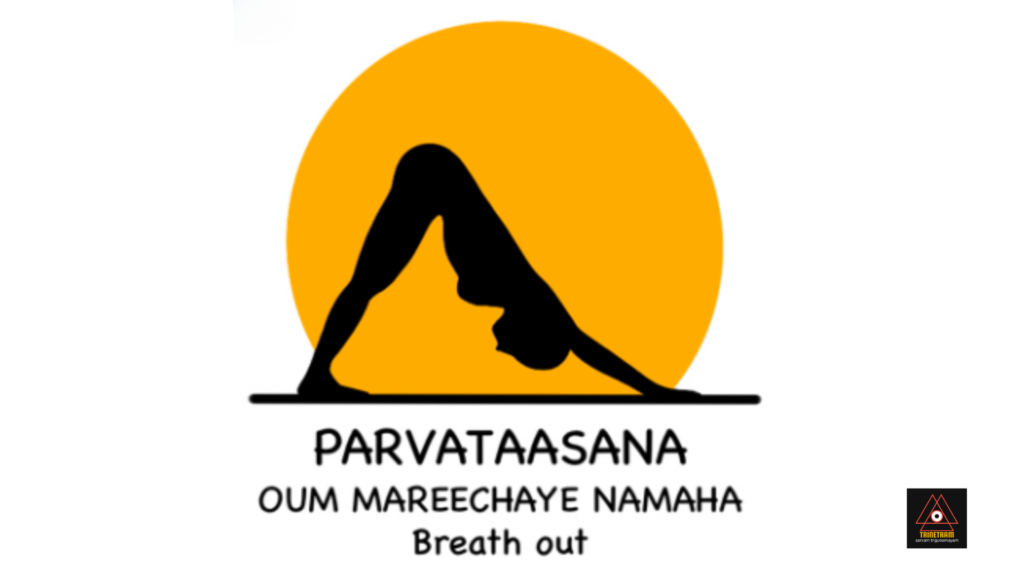
9.Ashwa Sanchalanaasana (Equestrian Pose) – Inhale, bring the right foot forward between the hands, keeping the left leg stretched back. Look upward, opening the chest. Repeating to balance energies.
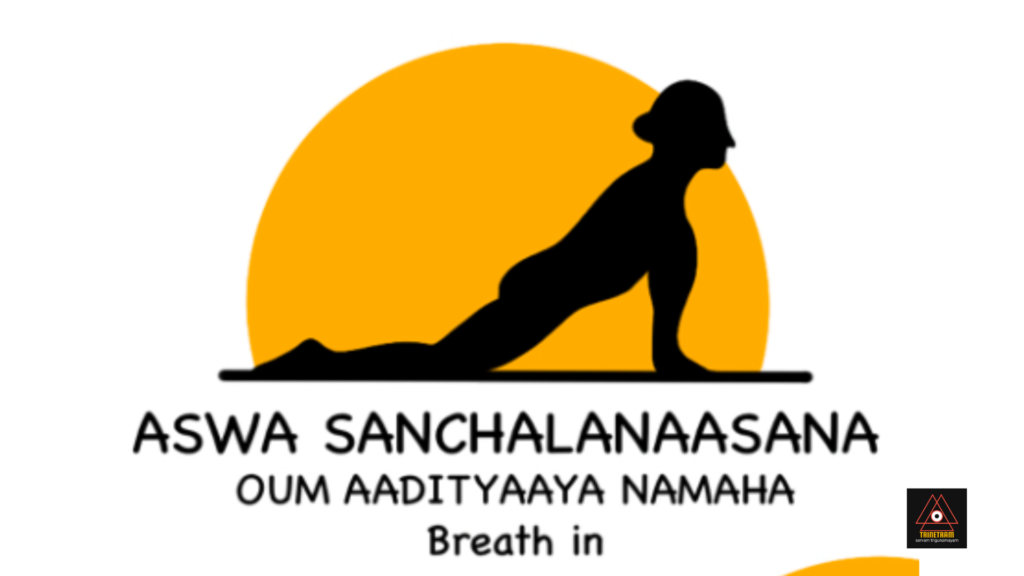
10.Padahastaasana (Hand-to-Foot Pose) – Exhale, bring the left foot forward, bending from the waist, placing the hands beside the feet, and keeping the knees straight. Grounds energy, aiding stability.
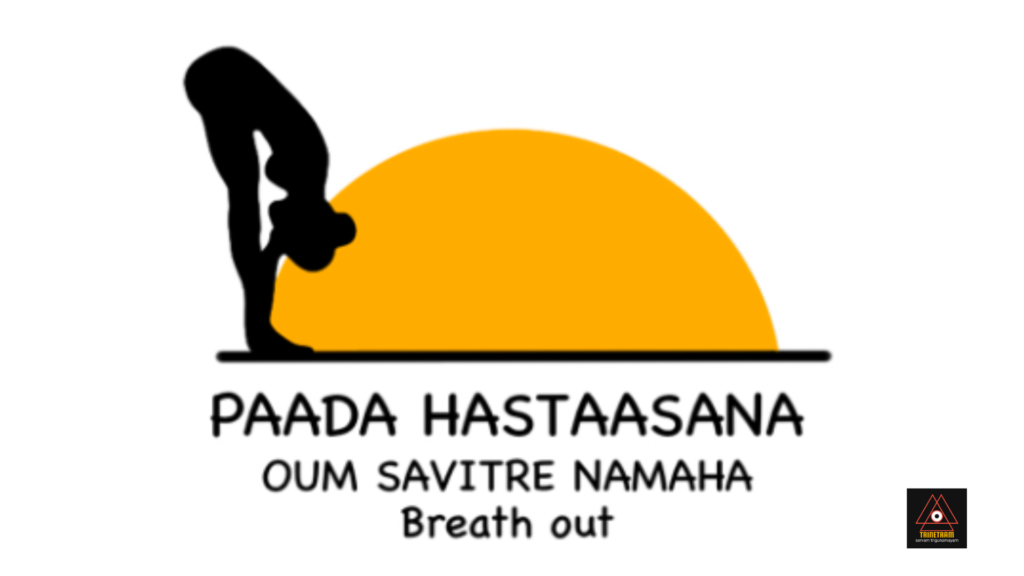
11.Hasta Uttanaasana (Raised Arms Pose) – Inhale, stretch the arms upward, arching slightly backward, and lengthening the spine. Reaching higher consciousness.
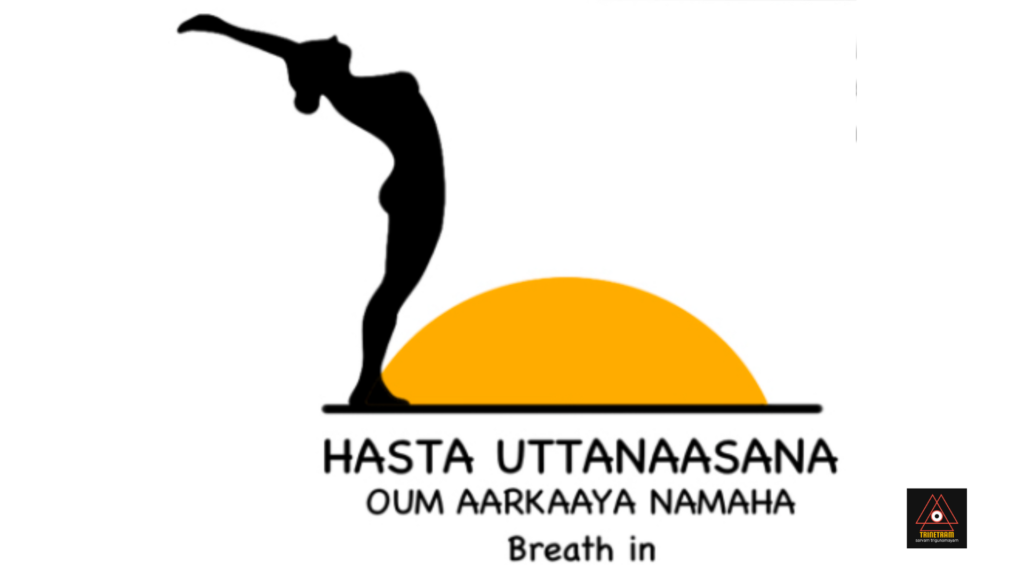
12.Pranamaasana (Prayer Pose) – Exhale, bring the hands back to the chest in Namaste, returning to the starting position, completing the cycle with gratitude. Completing the cycle with gratitude.
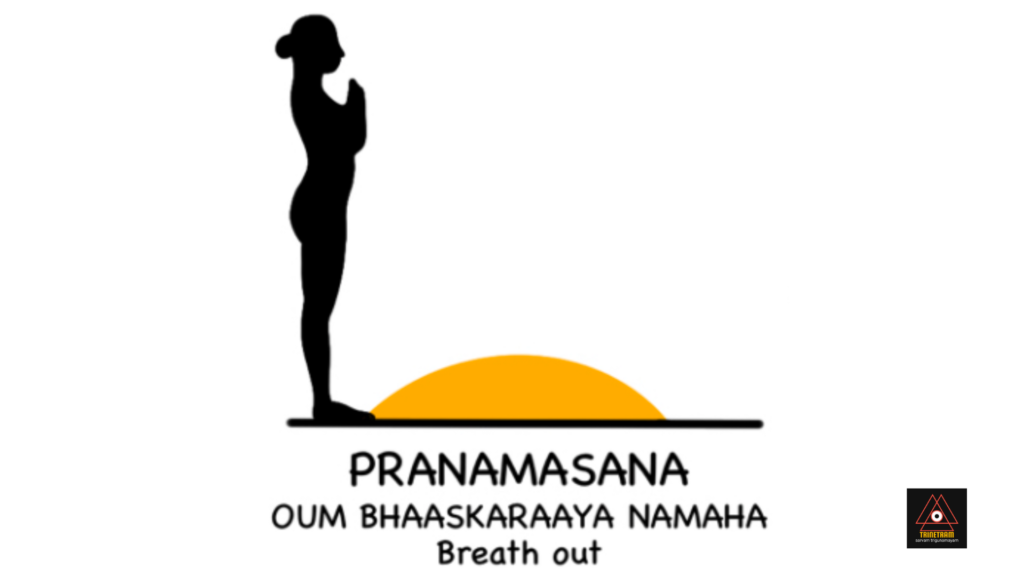
“नमः सूर्याय शांताय सर्वलोकनमस्कृते।”, Namaḥ Sūryāya Śāntāya Sarvalokanamaskṛte (Yajur Veda, Chapter 33, Verse 43). Means, “Salutations to Surya, the serene and worshipped by all worlds.”
3. Surya Namaskar and Chakra Activation
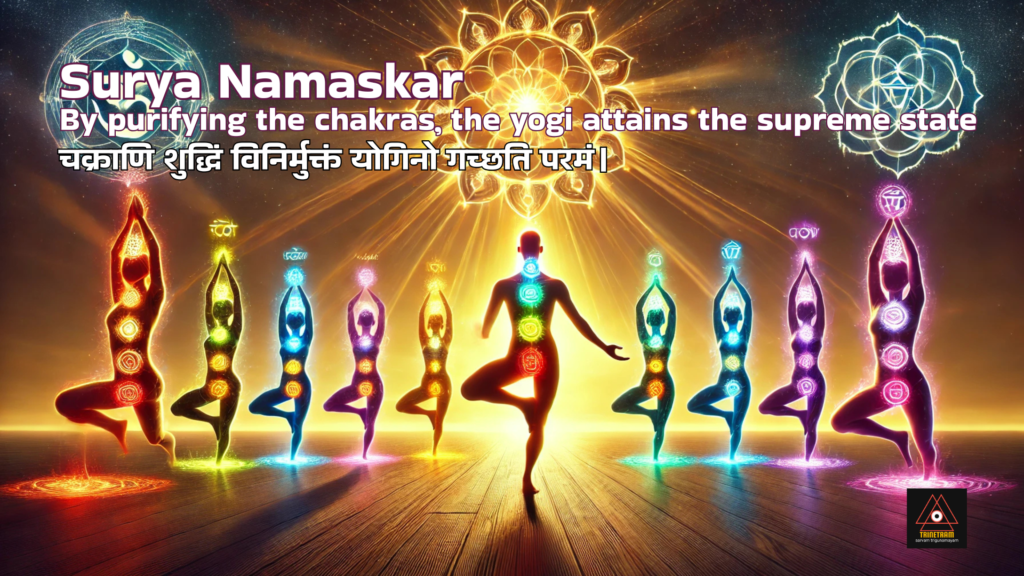
Each asana aligns and energizes different chakras, ensuring the free flow of Prana (life force energy) through the body. This process harmonizes Ida (moon energy) and Pingala (sun energy), bringing equilibrium.
“चक्राणि शुद्धिं विनिर्मुक्तं योगिनो गच्छति परमं।”, Cakrāṇi Śuddhiṁ Vinirmuktaṁ Yogino Gacchati Paramaṁ (Shiva Samhita, Chapter 2, Verse 12). Means, “By purifying the chakras, the yogi attains the supreme state.”
4. The Benefits of Sun Salutation
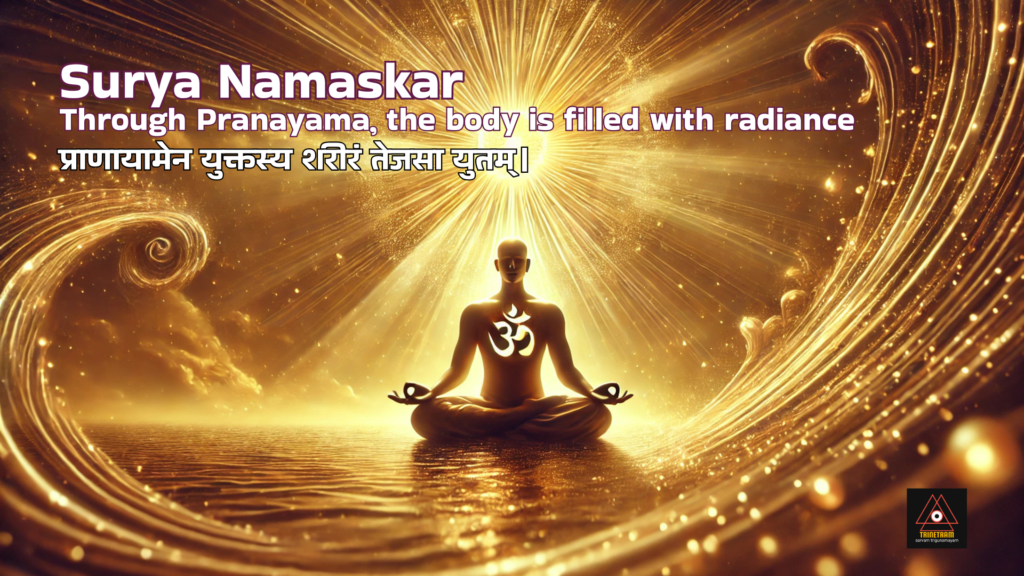
Physical Benefits:
- Improves flexibility, posture, and muscle tone.
- Enhances metabolism and strengthens internal organs.
Spiritual Benefits:
- Increases mindfulness and deepens meditation.
- Clears energy blockages, awakening Kundalini.
Energy Alignment:
- Balances solar and lunar energy channels (Ida & Pingala Nadis).
“प्राणायामेन युक्तस्य शरीरं तेजसा युतम्।” Prāṇāyāmena Yuktasya Śarīraṁ Tejasā Yutam, (Bhagavad Gita, Chapter 6, Verse 11) Means, “Through Pranayama, the body is filled with radiance.”
5. Best Time & Mantras for Surya Namaskar
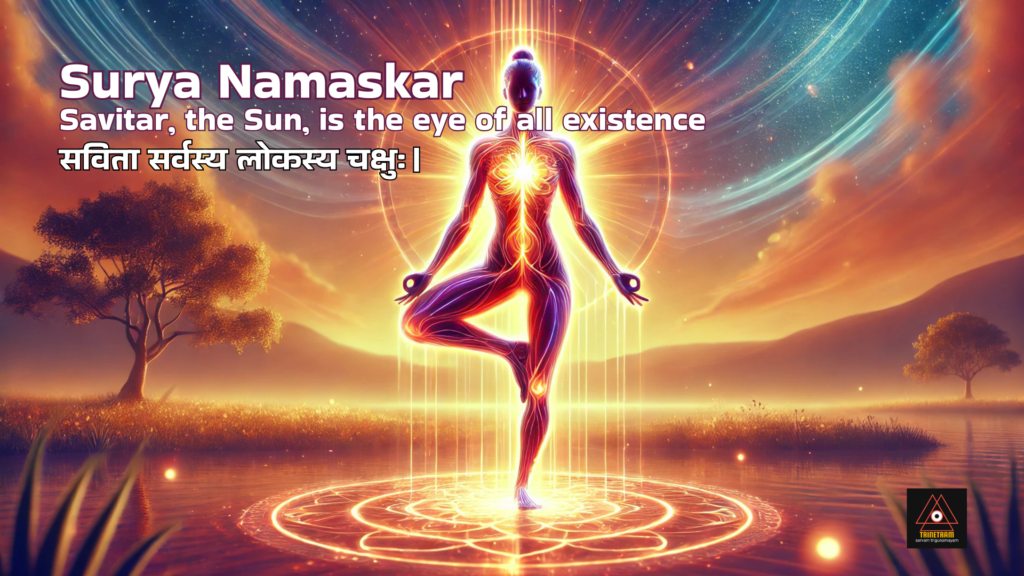
Sunrise is the ideal time for Surya Namaskar, as the body is fresh, and the mind is clear to absorb the solar energy.
12 Surya Mantras:
Each pose is associated with a mantra:
- Om Mitraya Namah – To the Friend of all.
- Om Ravaye Namah – To the Shining One.
- Om Suryaya Namah – To the Dispeller of Darkness.
- Om Bhanave Namah – To the Bestower of Light.
- Om Khagaya Namah – To the All-Pervading.
- Om Pushne Namah – To the Giver of Strength.
- Om Hiranyagarbhaya Namah – To the Golden Cosmic Self.
- Om Marichaye Namah – To the Lord of Dawn.
- Om Adityaya Namah – To the Son of Aditi.
- Om Savitre Namah – To the Stimulating Power of the Sun.
- Om Arkaya Namah – To the One Worthy of Praise.
- Om Bhaskaraya Namah – To the Bringer of Light.
“सविता सर्वस्य लोकस्य चक्षुः।” Savitā Sarvasya Lokasya Cakṣuḥ, (Rig Veda, Mandala 3, Sukta 62, Verse 10) Means “Savitar, the Sun, is the eye of all existence.”
6. Conclusion
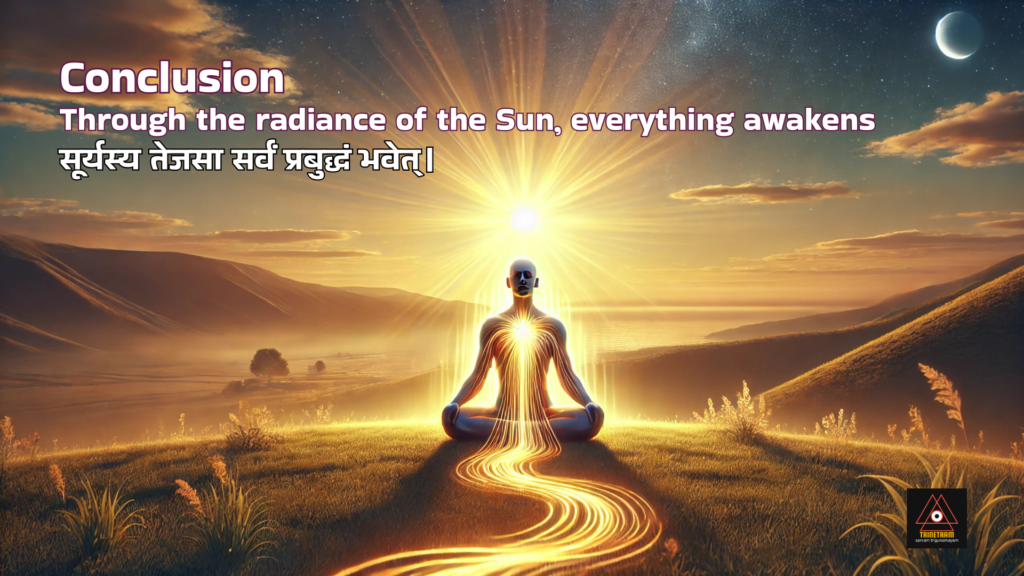
Surya Namaskar is not just a physical exercise; it is a spiritual ritual that aligns body, mind, and spirit with cosmic energy. Daily practice leads to:
- Higher states of consciousness.
- Inner peace and self-realization.
- Enhanced physical and spiritual well-being.
“सूर्यस्य तेजसा सर्वं प्रबुद्धं भवेत्।” Sūryasya Tejasā Sarvaṁ Prabuddhaṁ Bhavet, (Shiva Samhita, Chapter 5, Verse 18) Means, “Through the radiance of the Sun, everything awakens.”
Incorporating Surya Namaskar into daily practice is a transformative step toward enlightenment, aligning the physical body with the higher self. Let the Sun illuminate your path to spiritual awakening.
We will explore different types of Yoga in our upcoming blog. Until then, stay tuned to trinetramyc.com! 🌈
We would love to hear your valuable thoughts and insights to help us deepen this exploration.
Thank you,
Team Trinetram 🙏
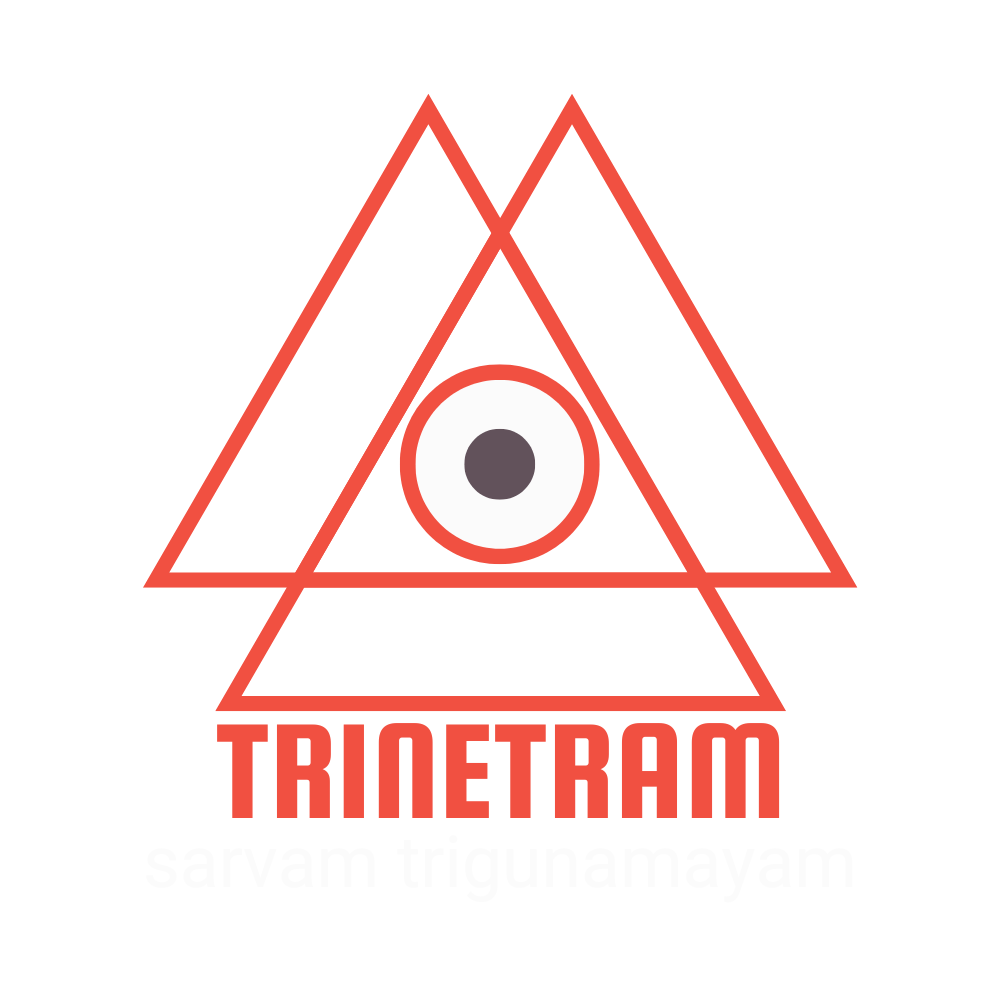
Leave a Reply